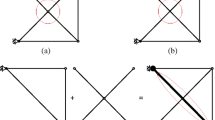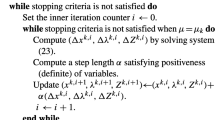Abstract
In this paper, several issues related to member buckling in truss topology optimization are treated. In the conventional formulations, where cross-sectional areas of ground structure members are the design variables, member buckling constraints are known to be very difficult to handle, both numerically and theoretically. Buckling constraints produce a feasible set that is non-connected and non-convex. Furthermore, the so-called jump in the buckling length phenomenon introduces severe difficulties for determining the correct buckling strength of parallel consecutive compression members. These issues are handled in the paper by employing a mixed variable formulation of truss topology optimization problems. In this formulation, member buckling constraints become linear. Parallel consecutive members of the ground structure are identified as chains, and overlapping members are added to the ground structure between each pair of nodes of a chain. Buckling constraints are written for every member, and linear constraints on the binary member existence variables disallow impractical topologies. In the proposed approach, Euler buckling as well as buckling according to various design codes, can be incorporated. Numerical examples demonstrate that the optimum topology depends on whether the buckling constraints are derived from Euler’s theory or from design codes.









Similar content being viewed by others
References
Achtziger W (1999a) Local stability of trusses in the context of topology optimization part I: exact modelling. Struct Optim 17:235–810 246
Achtziger W (1999b) Local stability of trusses in the context of topology optimization part II: a numerical approach. Struct Optim 17:247–258
AISC (2010) Specification for structural steel buildings. American Institute of Steel Construction
Arora J, Wang Q (2005) Review of formulations for structural and mechanical system optimization. Struct Multidiscip Optim 30:251–272
Cheng G, Guo X (1997) 𝜖-relaxed approach in structural topology optimization. Struct Optim 13:258–266
Cheng G, Jiang Z (1992) Study on topology optimization with stress constraints. Eng Optim 20:129–148
Dorn W, Gomory R, Greenberg M (1964) Automatic design of optimal structures. J Mec 3:25–52
EN 1993–1–1 (2005) Eurocode 3: Design of steel structures. Part 1-1: general rules and rules for buildings. CEN
Faustino A, Júdice J, Ribeiro I, Neves A (2006) An integer programming model for truss topology optimization. Investig Oper 26:111–127
Ghattas O, Grossmann IE (1991) MINLP and MILP strategies for discrete sizing structural optimization problems. In: Ural O,Wang TL (eds) Proceedings of the 10th conference on electronic computation. ASCE, pp 197–204
Grossmann IE, Voudouris VT, Ghattas O (1992) Mixed-integer linear programming reformulations for some nonlinear discrete design optimization problems. In: Floudas CA, Pardalos PM (eds) Recent advances in global optimization. Princeton University Press, pp 478–512
Guo X, Cheng G, Yamazaki K (2001) A new approach for the solution of singular optima in truss topology optimization with stress and local buckling constraints. Struct Multidiscip Optim 22:364–372
Guo X, Cheng G, Olhoff N (2005) Optimum design of truss topology under buckling constraints. Struct Multidiscip Optim 30:169–180
Gurobi Optimization Inc (2012) Gurobi optimizer reference manual. http://www.gurobi.com
Kanno Y, Guo X (2010) A mixed integer programming for robust truss topology optimization with stress constraints. Int J Numer Methods Eng 83(13):1675–1699
Ohsaki M, Katoh N (2005) Topology optimization of trusses with stress and local constraints on nodal stability and member intersection. Struct Multidiscip Optim 29:190–197
Rajasekaran S, Sankarasubramanian G (2001) Computational structural mechanics. Prentice Hall
Rasmussen M, Stolpe M (2008) Global optimization of discrete truss topology design problems using a parallel cut-and-branch method. Compu Struct 86:1527–1538
Rozvany G (1996) Difficulties in truss topology optimization with stress, local buckling and system stability constraints. Struct Optim 11:213–217
Ruukki (2011) Steel sections. Hollow sections. Dimensions and cross-sectional properties
Stolpe M (2004) Global optimization of minimum weight truss topology problems with stress, displacement, and local buckling constraints using branch-and-bound. Int J Numer Methods Eng 61:1270–1309
Stolpe M, Svanberg K (2001) On the trajectories of the epsilon-relaxation approach for stress-constrained truss topology optimization. Struct Multidiscip Optim 21:140–151
Wolsey LA (1998) Integer programming. Wiley
Zhou M (1996) Difficulties in truss topology optimization with stress and local buckling constraints. Struct Optim 11:134–136
Author information
Authors and Affiliations
Corresponding author
Appendix: Profile alternatives
Appendix: Profile alternatives
The data for the profile alternatives used in the numerical examples is given in Table 6. The profiles are square hollow sections with side length H and wall thickness T. In the text, a profile can be written as H x T. The data is taken from Ruukki (2011). For the L-shaped truss, the 21 first profiles are used. For the truss tower, profiles 1 to 13 and 22 to 28 are used. When resizing the truss tower solution without buckling constraints, profiles 29 and 21 were obtained for Euler buckling and Eurocode 3 buckling, respectively.
Rights and permissions
About this article
Cite this article
Mela, K. Resolving issues with member buckling in truss topology optimization using a mixed variable approach. Struct Multidisc Optim 50, 1037–1049 (2014). https://doi.org/10.1007/s00158-014-1095-x
Received:
Accepted:
Published:
Issue Date:
DOI: https://doi.org/10.1007/s00158-014-1095-x




